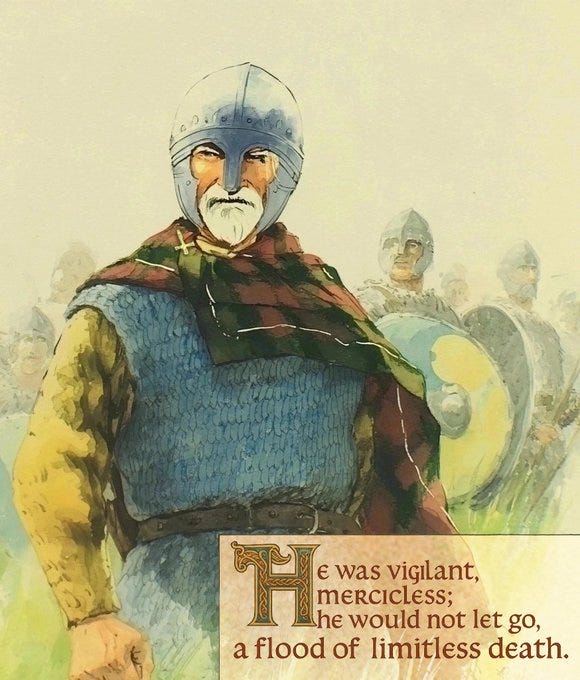Marwnad Cunedda and the Coeling
A glimpse of the Coeling from an outsider.
This is a subscriber exclusive expansion on a recent thread from X.
Marwnad Cunedda, or The Death-Song of Cunedda, celebrates the Northern warlord Cunedda, who later tradition attaches to the Gododdin, is an intriguing peek into the Brythonic Heroic Age, and stands as possibly one of the oldest extant Brythonic poems.
John Koch notes a number of points favoring the archaic dating of the poem, and places it as a genuine product of the 5th or 6th century. The poem makes no mention of the Anglo-Saxons, Cunedda's enemies are the Coeling, and the Men of Bryneich (Pre-Anglian Bernicia). The poem, if genuinely archaic gives additional weight to the Coeling as a semi-unified political entity in the North in the early period, as well as giving authenticity to the existence of Coel1 himself.
The poem is one of the most evocative of our extant Death-Songs, naming Cunedda a “Relentless attacker”, and that “chieftain will wear chieftain down to submission” and telling of Cunedda’s power “over the earth, like the sigh of the wind against the ash wood”. “His hounds will look back over his borderland”, and “clothe the rightfully qualified bards”. Cunedda is repeated described as a defensive bulwark “The thick defensive door at the wide breach” and “Merciless, without equal”. Marwnad Cunedda sings the highest praise possible for Cunedda.
While the poem at first glance seems like a standard praise and lament for the dead warlord, a few of the Coeling centric lines give me the notion of a different possibility. One of the first lines mentioning the Coeling appears quite early and states "They will hold fast with the Coeling in a truce of peace". This echoes the tradition of Coel's daughter marrying Cunedda, creating a peace between the two factions. Cunedda's wife is called Gwawl ferch Coel in the Jesus College pedigrees. Gwawl is not a common given name, literally meaning wall. Considering the locale of these figures, this is likely a reference to Hadrian's wall. Perhaps this 'marriage' was a treaty binding Cunedda to the lands north of the wall, and the Coeling south? It's still very possible this was cemented with marriage, but we can only speculate.
The supposed marriage to Coel’s daughter does help us possibly place Cunedda in a rough chronology. He could range from a younger contemporary of Coel, born late in the same rough generation, or belong to Coel’s children’s generation. Coel himself must be dated from his descendants. Working from Coel’s most easily dateable descendants we can establish a rough floruit for Coel from 410-440, which places Cunedda roughly in the middle of the 5th century. You could similarly work backwards from the Kings of Gwynedd, who supposedly descend from this northern Cunedda, however there is some reason to doubt their descent from Cunedda, which we will touch on later. If we look at Maelgwn, a supposed great-grandson of Cunedda, who is generally considered to be born around 500, we can establish a range. Considering an average 30 year generation (less useful for short spans like this, but increasingly better with more generations) Cunedda is placed with a birth around 410, giving him a floruit of 430-460 which considering his relation with Coel would be perfectly acceptable.
Keep reading with a 7-day free trial
Subscribe to Coeling Chronicler to keep reading this post and get 7 days of free access to the full post archives.



